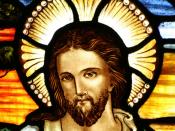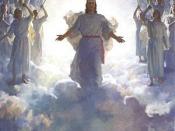Period Comparison
The two paintings I chose to compare are The Virgin and Child by Rogier van der Weyden (1406, Netherlandish; gallery room 207) and The Crucifixion by Francisco de Zurbaran (1627, Spanish; gallery room 215). These two paintings focus on Jesus Christ, his humanity and his divinity. I chose them because they represent Jesus' fragile humanity through his infancy and death. These paintings struck me as different from the other religious art I had seen because it stresses humanity without sacrificing divinity.
Weyden illustrates the beauty of humanity with a poignant portrait of The Virgin Mary breastfeeding Jesus as an infant. The sheer tenderness of this most simple and necessary bonding between the mother and the child is captured in this painting. It is a feeling that only a mother can understand but it is capable of touching everybody because everybody plays at least one of these roles throughout their lifetime.
The beauty and simplicity of human nature is also contrasted with the jewels that adorn Mary's robe and the velvet drape behind her. It seems to me that it implies divinity though one could also interpret that as something else. Although this was a painting for private devotion and intended to capture a beautiful moment, one can also see the dark side of human nature in this painting.
Exotic and expensive jewels surround Mary and Jesus. But why jewels? Why were jewels chosen to represent the divine? Jesus spoke against material riches saying that only those rich in spirit can enter the kingdom of Heaven. Jewels can also be interpreted as money and that is of course a necessary evil. If money is the root of all evil and human nature by definition is imperfect and tends to stray towards evil, then this painting takes on a whole...


Good reaction, bad art history
If you're looking for one person's reaction to two works of art, then this paper is pretty good. If you're supposed to reasearch something for an art history class, keep looking. Material wealth is a positive attribute in 15th century religious painting. Keep in mind that the catholic church was fabulously wealthy at the time, and that most major saints and figures were beautifully adorned to display the riches of the kingdom of heaven(see the virgin mary enthroned in heaven or the robes of the angels in other painrings of the period).
8 out of 8 people found this comment useful.